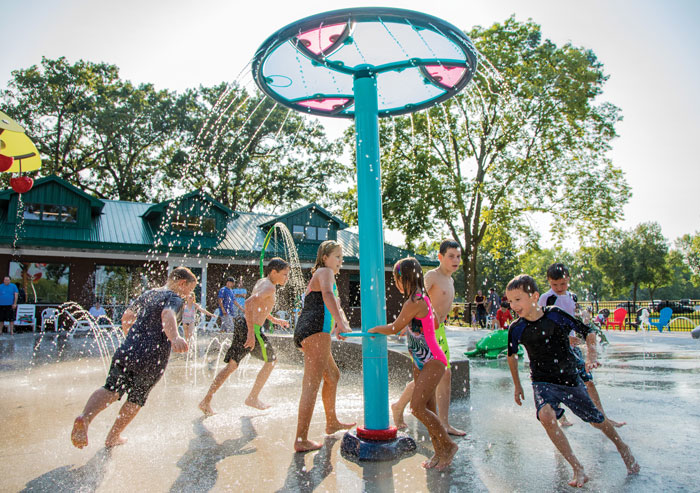Many municipalities and parks and rec departments continue to list splash pad areas as a top-planned amenity. “Splash play projects are being included now in most city budgets, and they are both standalone and recreation center additions,” said Wyeth Tracy, president of an Ontario, Canada-based splash pad manufacturer. And these amenities are also sprouting up in a lot of other varied locales, including resorts, YMCAs, housing complexes, campgrounds, zoos, aquariums, military bases, museums, cruise ships, schools and daycares. “Generally, the public splash pads are smaller while the larger spray parks are found in privately owned entertainment venues, hotels and resorts, waterparks and theme parks,” said Tracy.
Part of the excitement around splash pads is economics-based; while they certainly provide aquatic entertainment, the cost of their initial construction is far less than swimming and wading pools. Additionally, maintenance costs and equipment operating costs can be significantly lower than pools, especially true in pass-through water systems that don’t use any pumps or filters. These amenities are showing up indoors as well, though special attention must be given to heating and ventilation systems due to high humidity levels. “Indoor venues are more common in cold climates so they can be used year-round,” said Tracy. “With increasing temperatures, I would foresee these facilities becoming popular in very hot regions in the future.”
Pool-to-Splash Pad Conversions
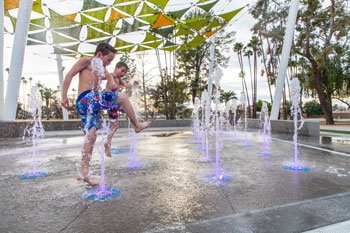
In fact, many communities are replacing their pools with splash pads or adding splash play features to existing pool
decks. “Adding splash areas to existing pools is most definitely growing in popularity, particularly with the growing volume of aging swimming pools,” said Barb Lapierre, regional sales manager at a Quebec, Canada-headquartered splash pad designer and manufacturer of splash products. “As well, as communities struggle to fill lifeguard positions, splash pads become an ideal solution, as neither lifeguards nor supervision is required. We see many communities replacing their pools with splash pads and even taking advantage of an existing pool footprint or pump room.”
Lapierre added that as temperatures continue to rise, parks directors are very much aware that their citizens need an area to recreate and cool off. “These new splash pads, with higher entertainment value, can then be rented out for party spaces or tied into existing summer programming.”
Splash pads have little or no standing water, and they often don’t need as many security features or administration facilities that are required for swimming pools. “Splash pads offer barrier-free play experiences that parents sometimes find hard to offer their children. This type of play falls outside of the structured and heavily scheduled team sports,” Lapierre said.
Sylvia Bucklew is the marketing coordinator for a St. Petersburg, Fla.-based manufacturer of splash play features and water filtration systems, and she said they are also seeing a lot of aquatic facility renovations where swimming pools are removed and replaced with a large spray park. “These spray parks gain revenue for facilities requiring patrons to purchase day passes for the waterparks and reserve picnic areas, and to offer a broader scale of activities for all age groups due to the lack of deep water.”
And she echoed the advantages of reducing operating costs as facilities need fewer lifeguards and less supervision. “For new construction, municipal spray parks tend to be standalone splash areas for the same reason.”
According to Jim Hartman, a regional manager at a San Marcos, Texas-based designer and manufacturer of water features and aquatic play equipment, parks and municipal projects are the majority of their business. “(We) and our agency partners work closely with municipalities to provide exciting water play amenities. In some cases, these splash pads are part of a larger new park build that includes playgrounds, walking trails, sports fields, etc. In other cases they are standalone splash pads.”
A Little Variety
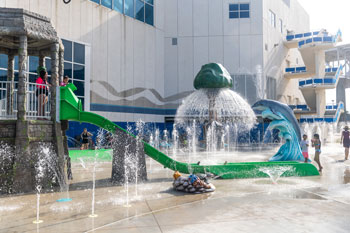
Offering a variety of play features to engage different age groups and encourage return visits is important. With many
features, players can pull knobs, push buttons, pedal, rock a toy, pump a handle or turn a crank to cause water sprays and create water displays. Ground jets can be arranged in creative patterns to create visual excitement. “Facilities are requesting features for spray parks that have added play value and keep patrons at the spray park for longer periods of time,” explained Bucklew. “These features need to be interactive, allowing patrons to manipulate the flow of water with gears and spinners.”
Many installation procedures have been designed to facilitate the upgrading or changing of features from year to year. “All of our products are surface-mounted without elaborate foundations, so they are readily interchanged or updated with new designs,” said Tracy.
Hartman said that even for those who don’t swap out features on a regular basis, they acknowledge that it’s nice to be able to do so. “Many of our features and nozzles are interchangeable if that is planned for during the design part of the project. It’s a great selling feature and allows customers to swap out features when they get damaged or when they want to change things up.”
Lapierre said it’s common—and recommended—in the planning stage to plan for future expansion. “As splash pads are often part of a growing community’s five-year plan, preparing for growth down the road just makes sense.”
She explained how their anchoring system allows for future expansion, making it easier to install splash pads with a plan to expand. “This type of system is a great solution for a phased approach with the water management system and infrastructure installed as part of the original phase. This also saves money and time.”
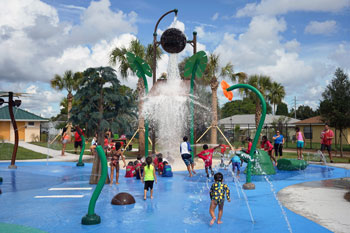
Larger, multi-level aquatic play solutions are also gaining traction, featuring age-appropriate games and diverse water effects on both upper and lower levels. Some are modular, fully customizable and can be retrofitted onto existing facilities. “There seems to be a major shift with what municipalities are wanting for their aquatic play programming,” said Lapierre. “Larger multi-level structures offer communities a type of commercial waterpark experience while still being affordable and community-driven. These structures offer play for the entire family, from designs that are geared for the 2- to 5-year-olds to large ‘wow’ multi-level features that entertain and engage older family members.
“In the last few years, we’ve seen real interest in ADA and inclusive multi-level aquatic play,” Lapierre continued. “With ramp access points and more interactive features at the lower deck level, (we’ve) been able to create designs that are truly for all ages and abilities.”
Bucklew said that inclusivity is a huge consideration when it comes to spray park design, and facilities must work closely with manufacturers and designers to ensure their park is inclusive. “Municipal spray parks bring communities together and allow residents to engage and socialize with one another, therefore it’s vital that all members of the community can engage with the aquatic play products.”
And theming continues to be very popular in spray park design, according to Bucklew. “Municipalities often request a themed spray park design that reflects the city’s history, preserving the culture of the community and extending it to younger generations. Other popular themes reflect the city’s local wildlife, mascot and colors.” Tracy agreed that themes are still a popular choice. “We’ve always created different themes to accommodate all venues. All of our themes have been developed from customer requests.” He mentioned their recent installation at a construction-themed waterpark in New Jersey—Diggerland USA—that features jackhammers, cranes, stoplights, buckets and more. Other themes in their catalog include pirates, baseball, zoo, racetrack and outer space.
Water Management
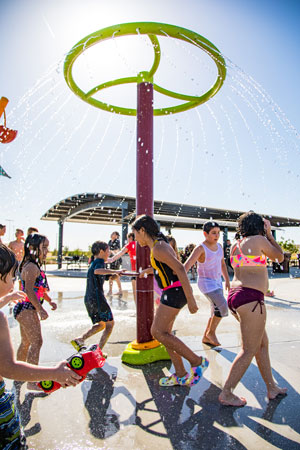
When it comes to water treatment, Hartman said the systems are oftentimes identical to swimming pools. “Water safety and cleanliness are the keys to successful water amenities. There are primary and secondary water treatment systems that will ensure that the water is safe.” Bucklew said that UV systems are a good option for spray parks. “UV provides secondary sanitation for spray parks and protects guests from pathogens that are tolerant to chlorine disinfection such as cryptosporidium, E. coli, etc.”
Hartman agreed that UV is a common water treatment strategy, and pointed out that it’s required in many states and municipalities.
There are two types of splash pad water systems—pass-through and recirculating. The former uses potable water from the city and is directly drained into the sanitary system, which means monitoring isn’t needed and the greatest cost for this system is the water. In some systems, the water can be collected and used for a graywater application, such as irrigation. Recirculating systems, on the other hand, collect the water in a holding tank where it is treated, filtered and pumped back out to the spray nozzles. These systems require scheduled water monitoring and chemical adjustments; though this system uses less water, monitoring is a cost to consider.
Bucklew’s company provides recirculating systems for spray park water management. She pointed out that while flow-through systems are relatively inexpensive initially compared to a recirculating system, making them appealing during the planning process, the con is that large spray parks need a lot of water to operate efficiently, and since these systems pull water from the city water lines, utility bills can get high quickly, “especially during hot seasons. Municipalities are also concerned about the environmental effects of using such large amounts of water, and we’re seeing a shift from flow-through to recirculating systems. These systems utilize a large tank that holds more water than the spray park needs, eliminating these concerns.”
“Recirculation systems are, of course, better environmentally,” said Tracy. “They are a higher initial cost but save on water expenses. I think they’re more common with most splash parks. Flow-through systems can have advantages in cost if the graywater is repurposed and turned into other purposes such as irrigation.”
In Greenwood, Ind., City Center Park offers a wide array of recreational activities, including the county’s first splash pad, which includes in-ground water features, dumping buckets and colorful shade structures, allowing for sitting and relaxing.
“The site of the current splash pad was once host to a 50-meter community pool,” said Rob Taggart, executive director of parks and rec in Greenwood. He said that while they haven’t thus far swapped out or upgraded features, as the facility is aging, “this will be something we look into very soon.” And as far as their water system, “It’s flow-through to a rain garden. We prefer the flow-through.”
Aesthetic Appeal
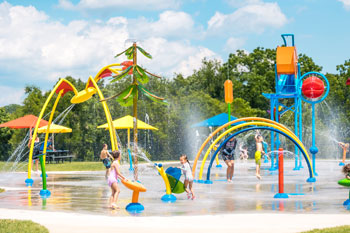
Splash pads have been following in the footsteps of modern playgrounds, offering not only innovative, interactive play features, but also colorful designs and creative layouts that highlight a certain artistic flair. Lapierre said that aesthetics is certainly one of the many considerations when designing splash pads, and added that they’ve created a playbook for designing a sustainable splash pad, “which details the important criteria for all social, economic and ecological needs. When it comes to the overall attractiveness of a splash pad, and this speaks to the popularity and the social equity it provides, the aesthetic appeal is very important.”
She described taking the time to meet with customers to understand what their overall goals are, including the environment and the surrounding landscape. “This could mean creating a beautiful garden-like space to fit in with the surrounding landscape or a very playfully colorful and more imaginative play-based design.”
In fact, sometimes splash play areas can double as centerpieces and be enjoyed even when the weather isn’t friendly for splashing. “We typically see this need when a splash pad is wanted in the center of town, or in a large common gathering area”, said Hartman. “It can be a challenge, but with utilizing our… line of fountain equipment, we can provide this ‘year-round’ type of amenity.”
Adding lighting to water features is one way to provide some “wow factor” to splash play areas. “This creates a dynamic interaction of light and water and makes a big impact on a splash pad.”
One arm of Hartman’s company offers equipment and design services for a variety of architectural fountain and interactive splash pad applications. He described one product series, a “pour-in-place” assembly containing a programmable on/off spray effect and 360-degree illuminating LED light fixture for interactive play.
“The assembly can be utilized for plaza-style water features or may be used for interactive splash pads. The patent-pending manual adjustment valve allows for the effect height to be adjusted from the top-plate without ever having to enter the can,” which houses the assembly.
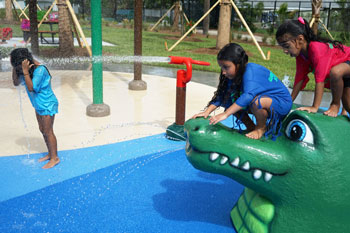
He also described an LED color-changing light fixture designed to illuminate both fountain and splash pad spray effects in underwater, wet or dry locations, which can be anchored to a finished surface or wall. “This fixture also has an on-board DMX controller that includes an angle adjustable yoke to position the fixture as desired.”
“Although modern architects have created barrier-free water basins for people to venture through, these fountains are rarely intended for play,” said Lapierre. But she added that they propose an innovative twist on fountains, transforming them into immersive, multi-sensory and interactive play experiences. Their playable fountains “invite people of all ages to rediscover the liberating sensations of water play without worrying about safety or water quality. These can be used year-round in some climates. They provide cooling and immersive play experiences day and night, in addition to a unique visual experience through dancing water jets and light.”
In Crystal River, Fla., a city improvement project included a 1,000-square-foot illuminated splash pad with synchronized deck jets and ground sprays. “The splash pad is in our town square park, which is in the middle of our downtown area,” said Leslie Bollin, events and marketing director for the City of Crystal River.
An activator in the fountain turns on various dancing ground sprays as they sequence between different movements and pressures. “There’s a button for users to hit to turn on the activators and they stay on for 15 minutes.”
The amenity offers seating and shade, and utilizes a recirculation system, acting as both a water play fountain and an illuminated water feature, timed to come on at dark and light up until 10 p.m.
“Lighted spray parks are becoming more popular as they create a multi-use water play area that becomes a lighted water feature during evening hours,” Bucklew said.
Innovations Abound
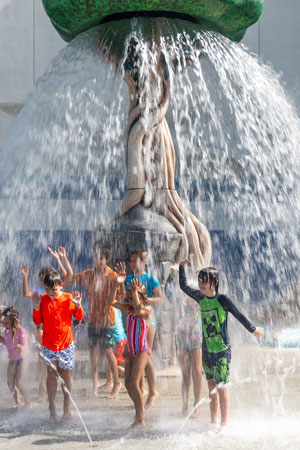
Facilities also need to ensure that there’s a draw for parents by providing the appropriate amenities to accommodate large families, according to Bucklew. “Restrooms, fencing, signage, bike racks, ample parking spaces, picnic areas, benches, drinking fountains, shade, trash and recycling receptacles need to be included in the planning process.”
And what other technologies are becoming common in splash pad designs? “Activators for spray parks are very popular and provide water savings by allowing patrons to turn the water on at their leisure,” said Bucklew. “These systems allow the water to turn off after a set amount of time, saving water at less busy hours.”
Added Tracy, “Automation is popular in the sites that have minimal supervision so that the features turn off when nobody is using the facility. Automation also provides an alternating display of water sprays and allows for reduced water flows and energy usage.”
Regarding other innovations, he said “We still consider our composite plastic fiberglass to be a space-age material with its lifetime corrosion warranty, low electrical conductivity and low heat conductivity.
“We’ve been producing water features for over 30 years and are now getting requests to replace some of our oldest equipment,” continued Tracy, who said their first waterslide/deck play structure is “20 years young and still going strong at the Stone Creek Golf Course in Valdosta, Georgia.”
Hartman said that splash pads are amazing amenities for municipalities to add, and whichever system they choose, can be enjoyed for many years. “The important thing to consider is each situation and work with them to give them the best option available to meet their needs.”
Added Lapierre, “In our experience, imaginative and open-ended abstract splash pad designs are always a hit with the whole community.” RM



